In 2018, the Indian classical music community lost many great artistes. CY remembers the contributions of some of these stalwarts like Annapurna Devi, Pt. Brij Bhushan Kabra and Pt. D K Katar.
Looking back on 2018, we remember a slew of Indian classical musicians who passed away, leaving behind them their legacies. We remember Annapurna Devi, who famously swore off public performances, Brij Bhushan Kabra, who pioneered the Hindustani lap slide guitar, and Pt. D K Katar, an engineer-turned-sarod-maestro, and more such artistes who have left behind them a legacy of knowledge passed on through their students and work.
Padma Bhushan Annapurna Devi
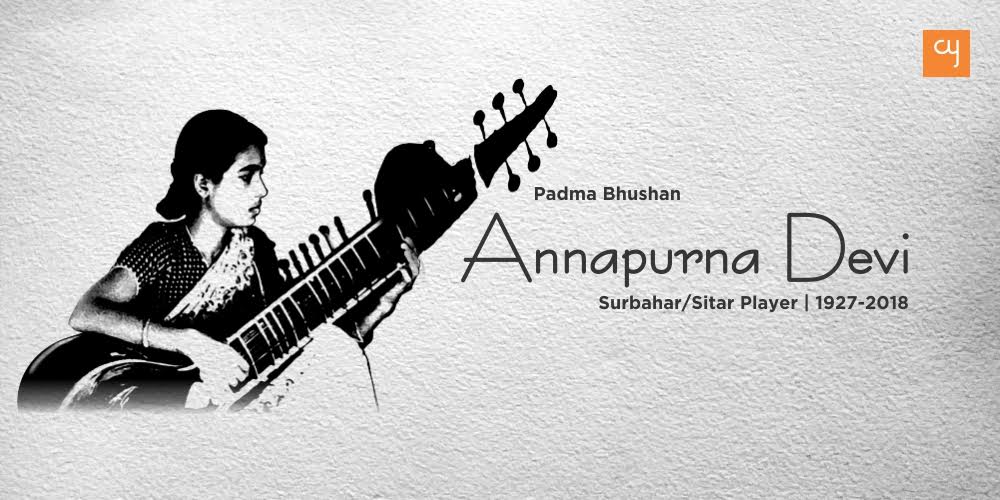
Surbahar/Sitar Player Listen
“I have great respect for women who stand up for what they believe in and fight for the cause of women against all odds.”
– From the 2005 biography ‘Annapurna Devi: An Unheard Melody’
On October 13 this year, musician and guru Annapurna Devi passed away in Mumbai. Born in Madhya Pradesh, Devi began learning music from a young age from the able hands of her father, the sitarist Ustad Allauddin Khan. Her father, however, had initially refused to train her for fear that this would make her an unsuitable wife and daughter-in-law. But one day, seeing how the 10-year-old Annapurna Devi, with no musical training, corrected her older brother’s incorrect exposition of a raag, Allauddin Khan started imparting to her his extensive knowledge. In her, he saw “infinite patience and a calm mind.” So he chose to forgo the popular and easily digestible sitar, and teach her a similar but more specialized instrument, surbahar, instead, based on the meditative dhrupad style of singing. In an article published in Navneet Samarpan, it is said that Annapurna Devi retreated into her bedroom from time to time and prayed to the photo of her father so that the wisdom that was given to her could be passed on in its truest form to her students, who lovingly called her guru maa.
At the tender age of 14, Devi’s marriage was arranged to none other than the sitar player Pt. Ravi Shankar, who was her father’s disciple. The music community is familiar with the controversies surrounding this marriage. One definitive thing to emerge from it was that Annapurna Devi put a stop to all public performances after their separation, and dedicated her life only to the private study of music. The world, however, continues to hear the echoes of her music from afar, through her students, some of whom have become the most well-known musicians of their era, like Pt. Hariprasad Chaurasia, Pt. Nikhil Banerjee, Nityanand Haldipurkar, Meena Ben Sukankar, Nanda Ji and Basant Kabra.
Padma Shri Pandit Tulsidas Borkar
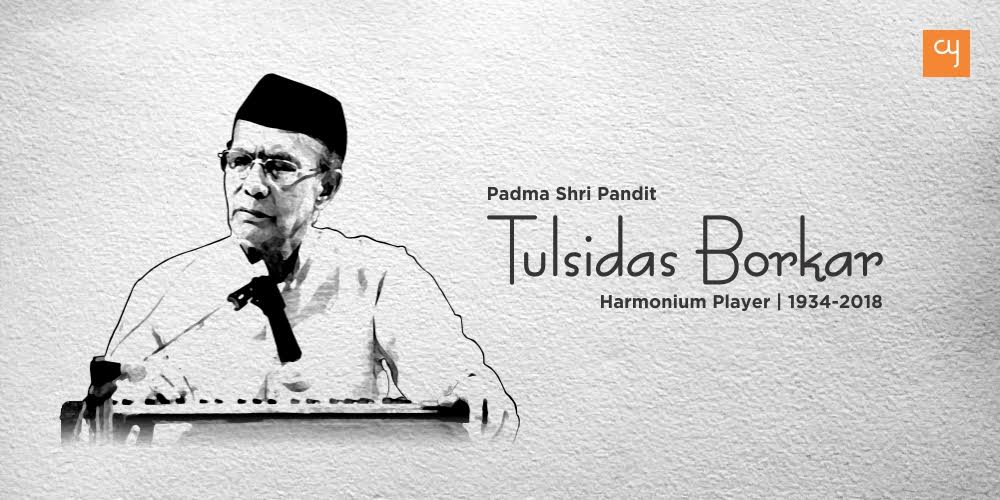
Harmonium Player Listen
“A true artist is one who understands the strong and weak points of his instrument.” – From a 2001 interview
As a young boy growing up in Goa, Tulsidas Borkar was naturally drawn to the sound of the harmonium that he often heard during temple prayers. Going on to become a maestro in playing this one instrument, Pt. Tulsidas also learned how to incorporate in it the best characteristics of other Indian classical instruments. For example, he played the harmonium in the Sarangi ang by imparting the qualities of the Sarangi, a string instrument, into his melodic phrases and approach to every note. He was also known for developing interesting finger techniques, having been trained under various instrumentalists (you can hear his unique take on the popular bhajan Payo Ji Maine Ram Ratan Dhan Payo here).
In addition to the traditional harmonium, Pt. Tulsidas also mastered the leg-harmonium, an organ that is used primarily in Marathi natyasangeet (stage musicals), which employs the use of the feet for air flow. He is also known to have taken interest in the violin. Pt. Tulsidas taught “lovingly and freely” and has left behind a legacy of students. He passed away on September 29 this year, aged 83.
Padma Shri Pandit D. K. Datar
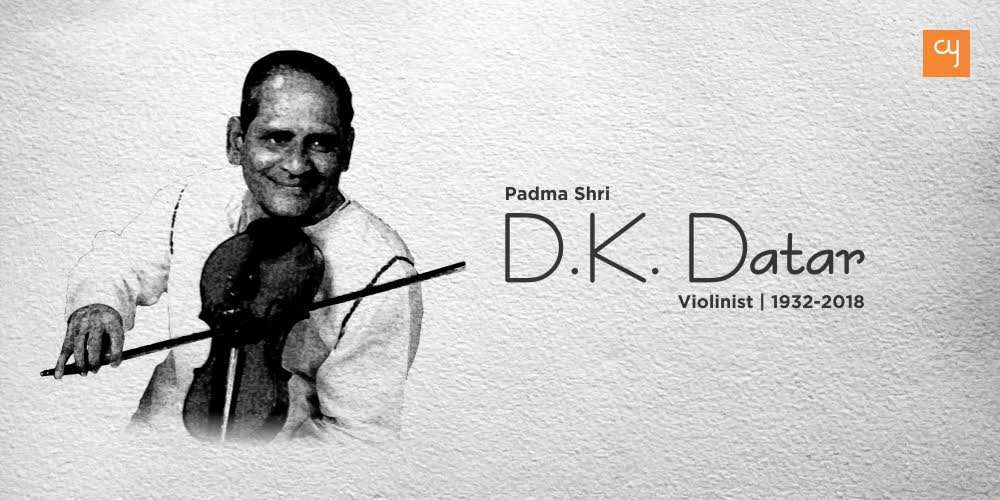
Violinist Listen
On October 10 this year, the music community lost eminent violinist Pt. D K Datar, whose calm exposition of raagas and unique gayaki ang (the use of techniques usually used only for singing) gave audiences the feeling that his violin was literally singing. Along with his peers Vidhushi N. Rajam and VG. Jog, Datar is considered one of the pioneers of the gayaki ang on violin. This style possibly developed as a result of his studies not just with Pt. Vigneshwar Shastri, but also with the well-known vocalist of the Gwalior gharana, Pt. DV Paluskar. He also received aid from another one of Pt. DV Paluskar’s students, Professor B. R. Deodhar, who ran one of the most reputable academies in Mumbai at the time. Though Datar could play classical music as well, his speciality was the bhajan and thumri (devotional and folk-inspired music).
By the age of 85, Pt. DK Datar had toured countless countries and accompanied a host of eminent vocalists at a great number of prestigious music festivals like the Sawai Gandharva of Pune and Saptak of Ahmedabad. Aside from accompanying his uncle Pt. DV Paluskar countless times, he also performed with vocalists like Hirabai Barodekar and Kishori Amonkar. GN Joshi, who worked as a sound engineer, remembers how DKDatar “assiduously mastered” anything he was given; be it playing different styles, or even writing his own music.
Ustad Aslam Hussain Khan
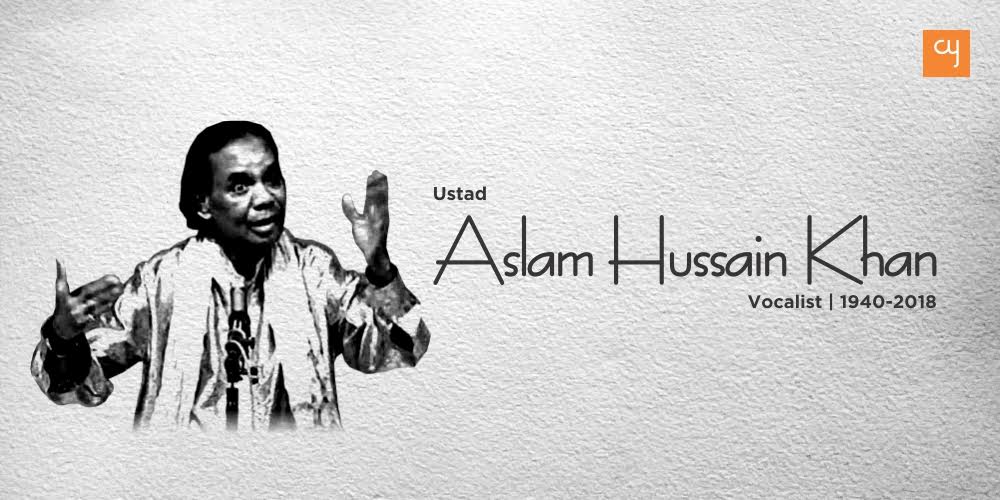
Vocalist Listen
“I want to give the best of my music, to all music lovers…”
– From website of Dilrang Academy of Music and Fine Arts
Ustad Aslam Hussain Khan was a vocalist who learned music from a whopping three gharanas – Khurja, Jaipur-Atrauli and Agra. This is remarkable considering that the gharana system tends to be rigid, usually. It is through the combined knowledge gained from each of his gurus– Haji Ustad Altaf Hussain Khan, Ustad Vilayat Hussain Khan and Ustad Khadim Hussain Khan– that he reached the height of mastery that he is known for. Though not recognised much by government honours, Ustad Aslam Hussain Khan’s legacy lay in the over 1000 compositions he wrote, and the students he trained diligently in his distinctive style that was defined by not one, but by three to four gharanas.
Over the span of 78 years, Ustad Aslam Hussain Khan recorded countless classical records (some of which were featured in films), became well versed in the life and work of musician Amir Khusro, and mastered several forms of music that traversed classical and ghazal styles. He passed away in Mumbai on March 21 of this year.
Pandit Arun Bhaduri
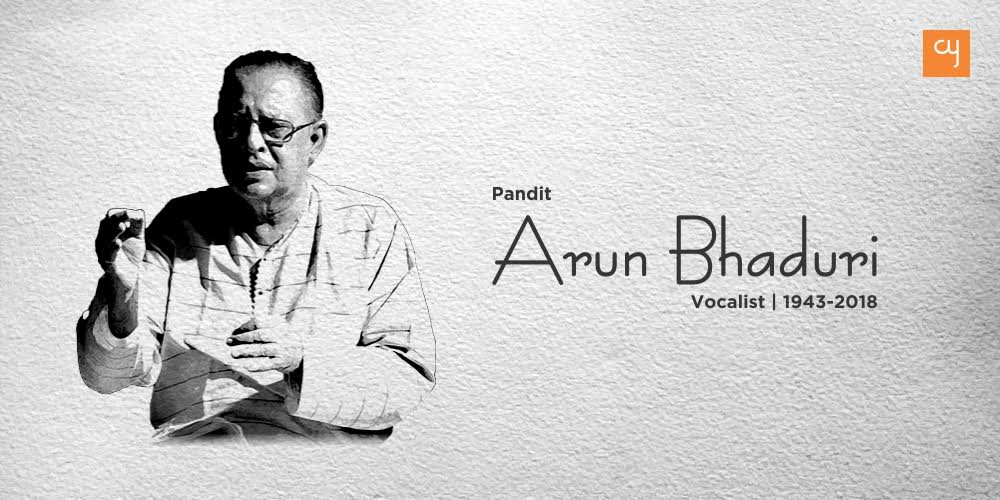
Vocalist Listen
In his childhood years growing up in a rural village, Arun Bhaduri was exposed to music primarily through the radio. Without a tanpura to practise with at first, he created his own simple ‘ektara’, a single-string instrument, so as to not miss out on his daily vocal practice. Bhaduri’s interest and experience in music eventually grew exponentially, and he went on to became a scholar at ITC Sangeet Research Academy in 1978. His training was done mostly under Pt. A Kanan, a renowned vocalist and teacher of his generation. Pt. Arun Bhaduri mastered the typical classical ‘khayal’ style of singing but was also very well-versed in Bengali light-classical songs and devotional songs, which he learned from Pt. Jnan Prakash Ghosh.
Pandit Arun Bhaduri of the Rampur-Sahaswan gharana was known for his melodious voice and comprehensive teaching style. He taught in Kolkata’sSangeet Academy and had many disciples, who are now carrying forward his legacy of paying tender attention to lyrics and rich tone. The well-respected vocalist passed away on the eve of December 17 at the age of 75.
Ustad Imrat Khan
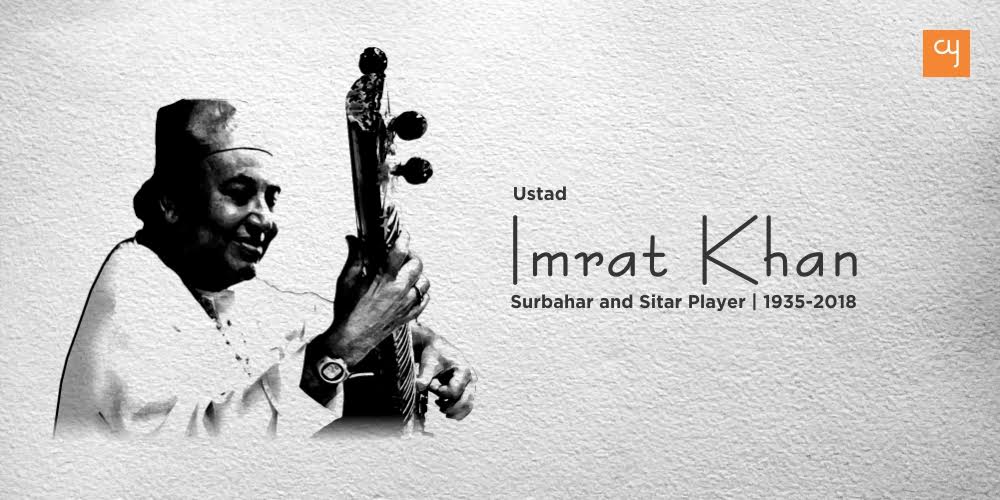
Surbahar and Sitar Player Listen
“Surbahar duniya ka sabse zyaada haseen saaz hai.”
(The surbahar is the world’s most beautiful instrument)
– From an interview aired in 2012
Ustad Imrat Khan’s tryst with the surbahar began at a very early age. His mother and brother assigned the rare instrument to him when he was only 6 years old, and thereon began his tryst with music! Son of the legendary sitar playerUstad Enayat Khan, he was blessed to learn music from a host of renowned family members, first from his uncle Ustad Wahid Khan, then from his brother Ustad Vilayat Khan. Additionally, he was close to the eminent singerUstad Bade Ghulam Ali Khan, from whom he learned how to keep his mind continuously occupied with music. Khan’s true legacy was solidified in the 50s in Kolkata when he tuned the surbahar to the tuning of a sitar so that he could play with his brother. From then on, he played countless concerts along with his brother, and eventually branched out to become a solo artist. He was a proponent of the Imdadkhani gharana.
Famously, Bollywood actor Dilip Kumar once took training from Khansaheb while preparing to enact the role of a musician. Through fortunate turns of fate, Khansaheb’s music became well recognised outside India, and he toured and taught a great deal in Europe and the United States. He was not very popular in India, however, which may be the reason why he settled outside of India in his final years. Though he was offered a Padma Shri at the age of 82, he declined it because he was already content with his “contributions in the name of the pure arts and culture of India”, and thought the award was too small and came too late in his career. His last posting was in St Louis, Missouri, USA, where he taught music at a university. The sitar and surbahar player passed away on 22 November at the age of 83.
Shree Banamali Maharana
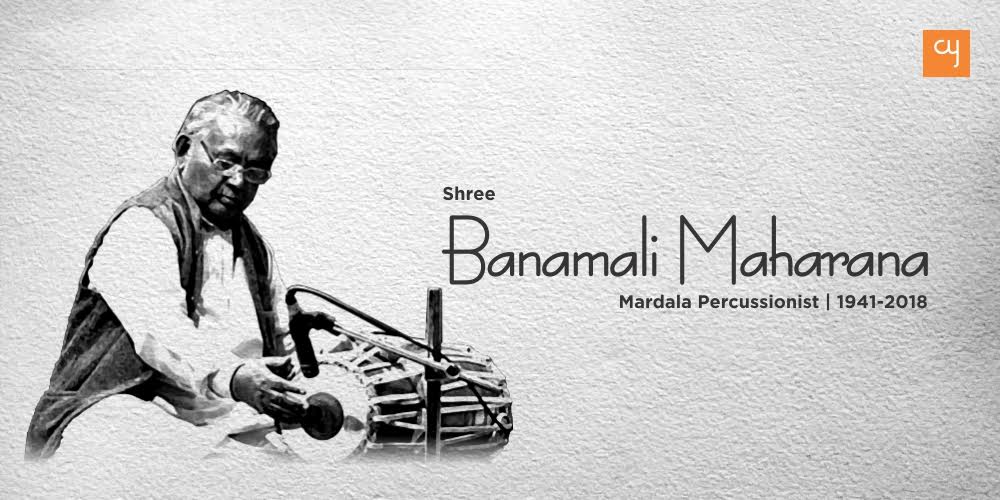
Mardala Percussionist
Though there are no easily available recordings of Guru Banamali Maharana’s music online, he was a recognised musician who specialised in playing with Odissi dance groups. The mardala is a percussion instrument that physically resembles a dhol and is used specifically to provide rhythm in Odissi dance. As a child, Guru Banamali Maharana dabbled in various instruments and eventually settled on playing the percussion instruments khol and dholak, when be became inspired by Mohan Sundardev Goswamy’s Raaslila. Later, under the training of well-known gurus, he learned the art of accompanying dance forms with the mardala.
Guru Banamali Maharana went on to accompany many well-known dancers such as Sonal Mansingh, Sujata Mohapatra, Sanjukta Panigrahi and Priyambada Hejmadi. But that was not all, he also taught at two music schools, eventually settling in Bhubaneshwar’s Utkal Sangeet Maha Vidyalaya. His legacy of bringing the percussion instrument of the mardala to new heights, and of training countless students, is remembered. The 77-year-old Guru Banamali Maharana passed away on November 17 this year.
Pandit Brij Bhushan Kabra
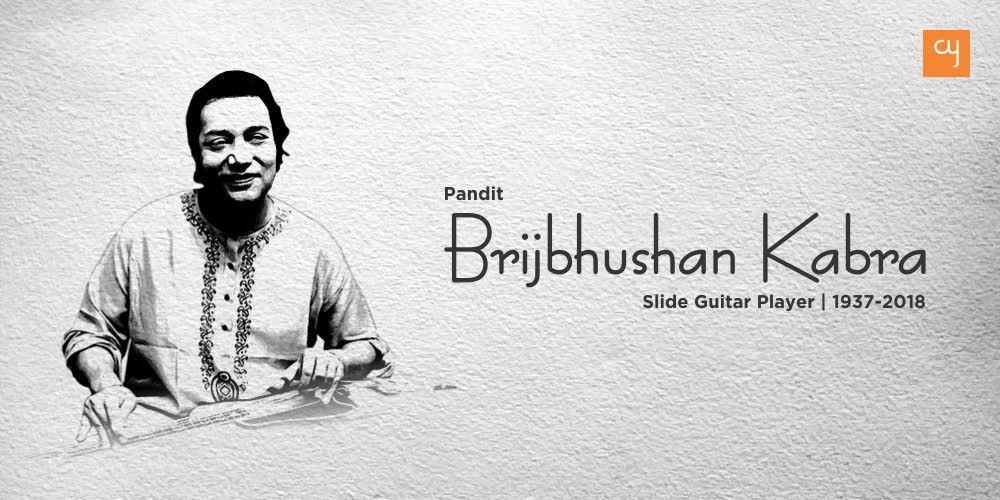
Slide Guitar Player Listen
Pt. Brij Bhushan Kabra was a pioneer in the Indian slide guitar. Though he was born in Jodhpur and was always surrounded by the arts, thanks to the area’s history of musical patronage and his musically inclined parents, he did not recognise his own musical affinity until much later when he began working in a business in Ahmedabad. On a trip to Mumbai, he spontaneously acquired a guitar, which was at the height of its popularity in India at the time, and realised he indeed had a liking for music. But he promised his father that he would only play Indian classical music on the western instrument. So with the aid of his guru, the eminent sarod player Ustad Ali Akbar Khan, Kabra went on to become a pioneer in the Indian slide guitar.Pt. Kabra’s‘big break’ came when he released the now famous album Call of the Valley, which also featured Pt. Hariprasad Chaurasia playing the flute and Pt. Shivkumar Sharma playing the santoor. Kabra integrated several influences into his work, including Rajasthani folk music, the classical violin and vocal music, to create a unique sound on a unique instrument.
In addition to being a well-respected musician, Kabra was also a philanthropist. His wife and him are credited with providing a great many village women with access to education. Several of his poetry books and educational papers were published as well. He was honoured with the Sangeet Natak Akademi Award in acknowledgement of his immense contribution towards popularising and configuring the lap slide guitar to what it is today. On April 12of this year, Pt. Brij Bhushan Kabra passed away at the age of 81.
Pandit Arvind Mulgaonkar
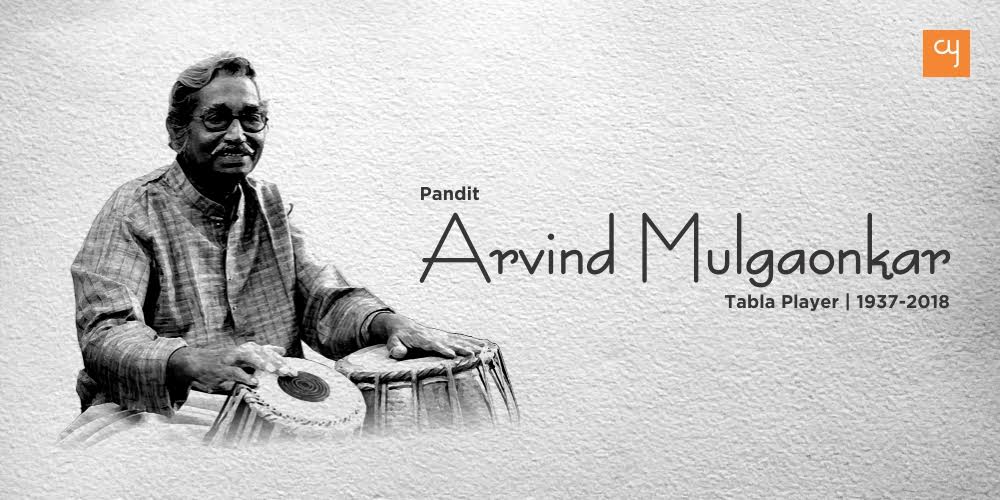
Tabla Player Listen
Pt. Arvind Mulgaonkar’s collection of theoretical books and DVD sets was a treasure in the tabla community. Spanning across the gharanas, the collection was held as a reputable source of reference for many students. This tabla maestro’s teaching style has been praised over the years. A student of his, Nitin Mitta, remembers that he would make sure that all his students got the“nikaas” (correct playing) of a composition right, sometimes even writing the compositions for them himself. Apart from teaching individual students in the traditional “Guru-Shishya parampara” tradition of Indian classical music, he kept the music of younger artists alive by organising concerts and competitions.
Mulgaonkar was trained in the Farrukhabad gharana under Ustad Amir Hussain Khan. To commemorate the memory of his guru, he created the Bandish Tabla Art Promotion Trust to give eminent artists a platform to perform and young students the opportunity to perform in competitions and learn from the best teachers. He is remembered as a soft-spoken and gentle teacher and his legacy, as described by his student, lies in the way his life was always dedicated to “promoting and upholding the tabla traditions of the past.”A recipient of multiple lifetime achievement awards, state and national awards and fellowships, Pt. Arvind Mulgaonkar also received a Sangeet Natak Akademi Award in 2016. This tabla maestro, writer and teacher passed away on February 27 of this year.
Pandit Buddhadev Dasgupta
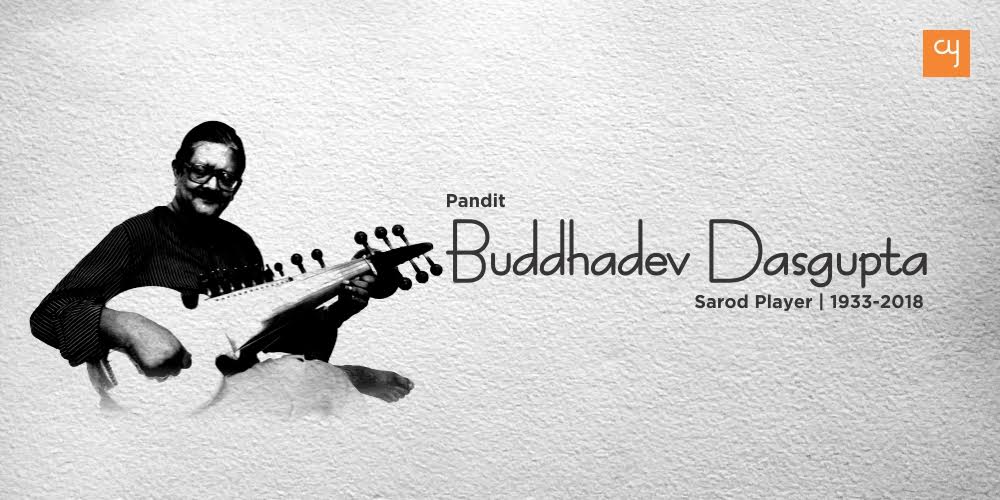
Sarod Player Listen
“I immediately fell for the instrument and also for the guru. That’s how my music started.”
What might be surprising to know is that the sarod maestro Pt. Buddhadev Dasgupta continued his musical practice alongside a professional career in the field of power engineering for 32 years. He would say that it was only “his guru’s blessings” that kept the thread of music alive in him. Since Pt. Gupta did not hail from a musical family, he was not necessarily destined to stumble into a life of music. But somehow, fate had him meet Pt. Radhika Mohan Maitra at the age of 10, under whom he became a lifelong student of music. Besides being influenced by his teacher, he was also influenced by the music of several other vocalists and instrumentalists like Ustad Bade Ghulam Ali Khan (vocal), Ustad Vilayat Khan (sitar) and Amir Khan. He “unhesitatingly” took “whatever good points that struck [him] from any other musician that [he] came by,” but never stooped to emulate or copy their style.
Musicological analysis was a large part of Pt. Gupta’s work. He completed years of research on Rabindranath Tagore’s classical influences and also gathered knowledge on his instrument, the sarod, and on its varying styles over its many gharanas. He researched on Western classical music as well, and presented all his knowledge at many universities around the world, as he was also well-known for his clear speeches and writing. Pt. Gupta constantly sought to grow and remained a lifelong “seeker of wonders and surprises within the boundaries of tradition.” The sarod maestro left for his heavenly abode on January 15, 2018.
Yatra Archives

 How Tulika Books is creating impact in children’s lives through picture books
Nandini Varma
How Tulika Books is creating impact in children’s lives through picture books
Nandini VarmaAug 21, 2019
A children’s book about a boy who feels like a girl. And about a child brought up by grandfathers. These are some of the stories published by Tulika Books, who have been making children’s picture books since 23 years. Little…
 Dalgona Coffee: A worldwide social media trend about home-made café experience
Harshil Shah
Dalgona Coffee: A worldwide social media trend about home-made café experience
Harshil ShahApr 2, 2020
While the lockdown has ignited various trends on social media, one that has received a major global following is #DalgonaCoffee. With thousands of posts on its name, here’s all you need to know about the Dalgona Coffee wave. I first…
 Leonardo, Michelangelo, Raphael and Donatello—Artists or Teenage Mutant Ninja Turtles characters?
Harshil Shah
Leonardo, Michelangelo, Raphael and Donatello—Artists or Teenage Mutant Ninja Turtles characters?
Harshil ShahNov 5, 2019
Did you ever wonder where the Teenage Mutant Ninja Turtles’ characters got their names from? Well, your search is complete. Here is a brief introduction of the artists from whom the creators of TMNT took inspiration. Teenage mutant ninja turtles,…
 The call of the mountains: orthopaedic Dr Yatin Desai’s advice on trekking
Himanshu Nainani
The call of the mountains: orthopaedic Dr Yatin Desai’s advice on trekking
Himanshu NainaniMay 24, 2019
In this piece 64 year old Dr Yatin Desai, shares with CY his inspiring story of how to scale towering mountains with utmost ease and how this life adventure activity can shape human character and health. Chances are high that…




